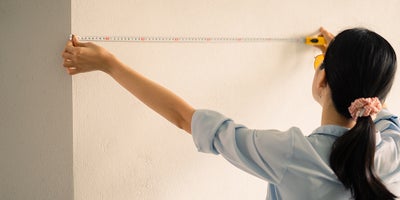When drilling holes into the back of a floating shelf, it can be really difficult to keep your drill bit straight. This is especially important when you’re drilling into a thin piece of wood like a shelf, as it’s easy for the bit to come out on one side if it’s at a slight angle. There are a couple of ways to avoid this:
If you’re a serial DIYer, you’ll probably have some scrap wood hanging around. You can glue two small straight pieces of scrap wood together by their long sides, offsetting them slightly so you get a 90° angled nook. Simply nestle your drill bit in this nook, and you’ll get a straight hole every time.
If you’re not one for a lot of DIY, you’re probably more likely to have an old CD hanging around. When drilling vertically, place this CD over where your hole will be, and use the reflective side to see how straight your drill is when working. You can keep your eye on this reflection while drilling and adjust as you go. It’s surprisingly easy to gauge whether your drill is straight using this method as you’ll know it’s at an angle if it begins to creep into view. While it may sound like a bit of a novel idea, it generally yields great results.

